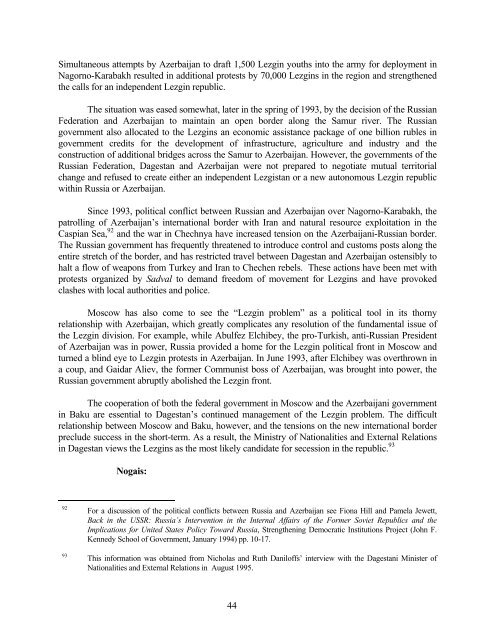RUSSIA'S TINDERBOX - Belfer Center for Science and International ...
RUSSIA'S TINDERBOX - Belfer Center for Science and International ...
RUSSIA'S TINDERBOX - Belfer Center for Science and International ...
Create successful ePaper yourself
Turn your PDF publications into a flip-book with our unique Google optimized e-Paper software.
Simultaneous attempts by Azerbaijan to draft 1,500 Lezgin youths into the army <strong>for</strong> deployment in<br />
Nagorno-Karabakh resulted in additional protests by 70,000 Lezgins in the region <strong>and</strong> strengthened<br />
the calls <strong>for</strong> an independent Lezgin republic.<br />
The situation was eased somewhat, later in the spring of 1993, by the decision of the Russian<br />
Federation <strong>and</strong> Azerbaijan to maintain an open border along the Samur river. The Russian<br />
government also allocated to the Lezgins an economic assistance package of one billion rubles in<br />
government credits <strong>for</strong> the development of infrastructure, agriculture <strong>and</strong> industry <strong>and</strong> the<br />
construction of additional bridges across the Samur to Azerbaijan. However, the governments of the<br />
Russian Federation, Dagestan <strong>and</strong> Azerbaijan were not prepared to negotiate mutual territorial<br />
change <strong>and</strong> refused to create either an independent Lezgistan or a new autonomous Lezgin republic<br />
within Russia or Azerbaijan.<br />
Since 1993, political conflict between Russian <strong>and</strong> Azerbaijan over Nagorno-Karabakh, the<br />
patrolling of Azerbaijan’s international border with Iran <strong>and</strong> natural resource exploitation in the<br />
Caspian Sea, 92 <strong>and</strong> the war in Chechnya have increased tension on the Azerbaijani-Russian border.<br />
The Russian government has frequently threatened to introduce control <strong>and</strong> customs posts along the<br />
entire stretch of the border, <strong>and</strong> has restricted travel between Dagestan <strong>and</strong> Azerbaijan ostensibly to<br />
halt a flow of weapons from Turkey <strong>and</strong> Iran to Chechen rebels. These actions have been met with<br />
protests organized by Sadval to dem<strong>and</strong> freedom of movement <strong>for</strong> Lezgins <strong>and</strong> have provoked<br />
clashes with local authorities <strong>and</strong> police.<br />
Moscow has also come to see the “Lezgin problem” as a political tool in its thorny<br />
relationship with Azerbaijan, which greatly complicates any resolution of the fundamental issue of<br />
the Lezgin division. For example, while Abulfez Elchibey, the pro-Turkish, anti-Russian President<br />
of Azerbaijan was in power, Russia provided a home <strong>for</strong> the Lezgin political front in Moscow <strong>and</strong><br />
turned a blind eye to Lezgin protests in Azerbaijan. In June 1993, after Elchibey was overthrown in<br />
a coup, <strong>and</strong> Gaidar Aliev, the <strong>for</strong>mer Communist boss of Azerbaijan, was brought into power, the<br />
Russian government abruptly abolished the Lezgin front.<br />
The cooperation of both the federal government in Moscow <strong>and</strong> the Azerbaijani government<br />
in Baku are essential to Dagestan’s continued management of the Lezgin problem. The difficult<br />
relationship between Moscow <strong>and</strong> Baku, however, <strong>and</strong> the tensions on the new international border<br />
preclude success in the short-term. As a result, the Ministry of Nationalities <strong>and</strong> External Relations<br />
in Dagestan views the Lezgins as the most likely c<strong>and</strong>idate <strong>for</strong> secession in the republic. 93<br />
Nogais:<br />
92 For a discussion of the political conflicts between Russia <strong>and</strong> Azerbaijan see Fiona Hill <strong>and</strong> Pamela Jewett,<br />
Back in the USSR: Russia’s Intervention in the Internal Affairs of the Former Soviet Republics <strong>and</strong> the<br />
Implications <strong>for</strong> United States Policy Toward Russia, Strengthening Democratic Institutions Project (John F.<br />
Kennedy School of Government, January 1994) pp. 10-17.<br />
93 This in<strong>for</strong>mation was obtained from Nicholas <strong>and</strong> Ruth Daniloffs’ interview with the Dagestani Minister of<br />
Nationalities <strong>and</strong> External Relations in August 1995.<br />
44
















